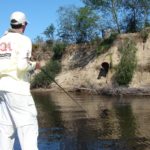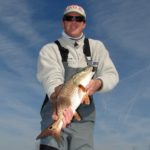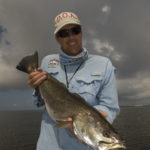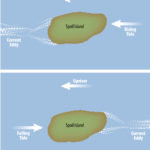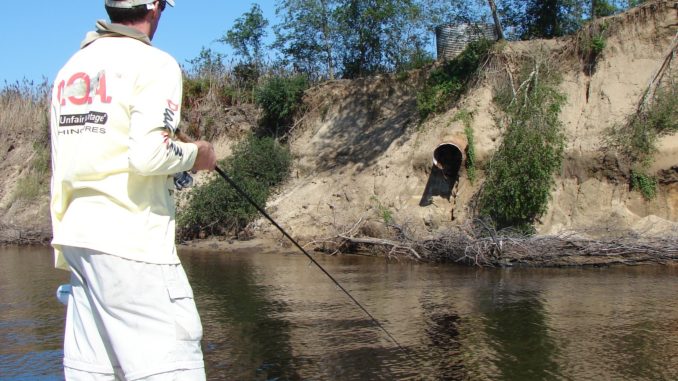
Dredging in big North Carolina river has created plenty of fish-holding spoil island between Wilmington and Southport.
As he pulled away from the ramp it Carolina Beach, Stuart Caulder said he expected to catch a few trout early and then look for some red drum as the tide rose enough to let him get into the shallows around a few of the spoil islands in the Cape Fear River.
The run through Snows Cut to the Cape Fear River was a short one, and soon, Caulder was looking at a current streak where the rising tide pushed along the edge of a spoil island. Pockets of rip-rap along the bank disrupted the current, producing swirls and eddies, and Caulder slipped his trolling motor over to ease within casting distance.
The water was too deep for his Power-Pole, so Caulder carefully eased his anchor over the side, trying to avoid spooking any fish, even though he said fish living near the Cape Fear Shipping Channel are used to a little more noise than those in smaller and more protected waters.
“Let’s see if anyone is home and hungry,” Caulder said. “Y’all work the bottom with these paddletails and shrimp, and I’ll make a few casts with this Top Pup to see if anything is feeding on top. I know it’s late for topwaters, but the water and weather have stayed fairly warm this fall. Last Tuesday, I caught a couple of trout on topwaters early and switched everyone over, and we had a great time catching both trout and reds. Maybe we’ll get lucky again.”
Caulder pointed to the shoreline and directed his anglers to cast upcurrent, along the edge of the exposed rocks, to hold the rod tip up and let the bait sink, then twitch it off the bottom just a little bit and let the current push it past the rocks and down the bank.
As good as it looked, this spot didn’t produce, so Caulder pulled the anchor and used the trolling motor to work down the bank of the island. After about 100 yards, something hit the D.O.A. shrimp, and Caulder quickly dropped the Power-Pole to hold the position. It took a few casts to draw another strike, but a nice redfish grabbed the shrimp and surged down the bank. A few minutes later it was led to the boat and netted, then released.
“I really like to get that first fish to the boat,” Caulder said. “It seems like it sets the tone for the day. That looked to be just off the bank, so be sure to cast up there close. If you don’t occasionally land a cast in the grass on or the bank, you’re not trying hard enough.”
A trout bit a short time later, but it was the only strike, and Caulder soon moved on, saying that this late in the fall, the reds should be schooling, wondering aloud if the warmer-than-usual water temperature had anything to do with it. Caulder worked down the bank until he crossed into still water behind the current swirls trailing off the upriver end of the island.
“These islands usually hold fish, but boat activity, freshwater running down the river and having bait or not affects them,” Caulder said. “The current is eroding them as it brings bait to them, and the fish follow the bait. The tidal current pushes bait up the river while the tide is rising and carries it back down the river when the tide is falling, so these islands have might have bait whether the tide is rising or falling.”
Caulder said there is an eddy on the downcurrent end of every spoil island where the faster-moving water on the channel side merges with the slower-moving water on the side away from the channel. The eddies trap smaller shrimp and minnows and tire larger ones while confusing them, making for a favorite feeding spot for larger predator fish.
As the tide changes, the ends of the islands will change from upcurrent to downcurrent. The speed of the current varies during the tide cycle, and this can affect where along the island fish are feeding. Beginning at the short pause between tides, the speed of the tide gradually increases to just past mid-tide and then begins slowing. The larger fish look for places they can be out of the current but next to it so they can dart out and grab something, then return to their hideout out of the current.
Red drum and flounder don’t seem to mind the stage of the tide and whether the current is running fast or slow — at least not as long as it is carrying baitfish and shrimp. The tide in the Cape Fear River runs pretty quickly, and in the colder months, trout fishing sometimes slows at the peak of the tide and picks back up in the last hour or two of the cycle. Many fishermen prefer to fish the last two hours of a tide and the first two hours of the next tide, when the water is moving at its slowest pace.
“When you fish these islands, you should be prepared to fish topwater, shallow or deep,” Caulder said. “You don’t know where the fish may be, and most of them have a variety of topography that includes everything from steep drops to shallow flats with sand, mud or rock bottoms. The tide running past them is constantly changing them, and they sometimes fish a little different than the last trip.
“I arrive with a topwater, a suspending bait, a slow-sinking bait and a bait that will sink quickly,” Caulder said. “I like Top Pups for topwater, MirrOdines for suspending lures and D.O.A. shrimp, paddletails and jerkbaits for fishing the bottom.”
Caulder said the bite will be different early and late than during the middle of the day. This time of year, the bite often begins slow and picks up as the sun rises and the water warms — exactly the opposite of the summer when the water is warm and fish feed early and late to escape the heat.
The stage of the tide affects the bite, too, he said. In cooler water, it costs fish less energy to feed when the current is running slower, as it is early and late during the cycle. Some islands that are close together have flats between them on the side away from the channel that may only be accessible during higher stages of the tide.
Between Wilmington and Southport, the river features around 20 spoil islands of diverse compositions ranging from mostly sand to rock and even ballast stone from sailing ships that traveled the river in the past. Numerous dredging projects have created islands that stretch along the channel, and the mixture of materials has created diverse habitat for a variety of fish. Not all of them hold fish, but many of them do. Caulder checks them regularly and finds redfish, speckled trout, flounder, stripers and an assortment of others.
DESTINATION INFORMATION
HOW TO GET THERE — With approximately 20 spoil islands dotting the Cape Fear River between Wilmington and Southport, either place, along with Carolina Beach and Wrightsville Beach, offers good boating access. US 17, US 421, US 74 and I-40 will put most fishermen living in North Carolina within reach of these communities. Two ramps in Wilmington will serve most boaters’ needs: Dram Tree Park on the waterfront next to the US 76/421/17 bridge and River Road Park. Carolina Beach has a public ramp on the south side of the ICW off US 421 at Snows Cut and a fee ramp at Carolina Beach State Park. A public ramp at Fort Fisher at the end of US 421 is available.
WHEN TO GO — The Cape Fear River holds speckled trout year-round, but the fall bite is generally considered the best; it typically ramps up during October and stays pretty strong into December. From late November through March, there may be stripers mixed with the trout around the spoil islands upriver from Snows Cut. Red drum are also found in the Cape Fear River all year and fishermen shouldn’t be surprised to catch an occasional flounder, even in mid-winter.
BEST TECHNIQUES — Medium-light to medium-action spinning or baitcasting tackle is the deal; 7-foot rods are preferred for their ability to make long casts. Spool up with braided line, but use a 2-foot fluorocarbon leader, tying on all lures with a loop knot. Soft-plastic jerkbaits, paddletails and shrimp fished on jigheads are productive baits. In heavy cover, go to a swimbait hook. Topwater lures come into play early in December. When the water temperature drops below 56 or 57 degrees, go with suspending baits like MirrOdine 17 MR and 27 MR.
FISHING INFO/GUIDES — Stu Caulder, Gold Leader Fishing, 910-264-2674; Tex’s Tackle and Bait, Wilmington, 910-791-1763, www.texstackle.com; Island Tackle and Hardware, Carolina Beach, 910-458-3049, www.islandtacklehardware.com. See also Guides and Charters in Classifieds.
ACCOMMODATIONS — Best Western/Coastline Convention Center, Wilmington, 800-617-7732, www.coastlineinn.com; MainStay Suites, Wilmington, 910-392-1741, www.mainstaywilmingtonnc.com; Sleep Inn, Wilmington, 910-313-6665, www.sleepinwilmingtonnc.com; Cape Fear Convention and Visitors Bureau, 877-406-2356, www.cape-fear.nc.us.
MAPS — GMCO Chartbook of North Carolina, 888-420-6277, www.gmcomaps.com; Capt. Segull’s Nautical Charts, 888-473-4855, www.captainsegullcharts.com.

